The Golden Age of Science Fiction: Fantasy Newsletter
The Balrog Award, often referred to as the coveted Balrog Award, was created by Jonathan Bacon and first conceived in issue 10/11 of his Fantasy Crossroads fanzine in 1977 and actually announced in the final issue, where he also proposed the Smitty Awards for fantasy poetry. The awards were presented for the first time at Fool-Con II at the Johnson County Community College in Overland Park, Kansas on April 1, 1979. The awards were never taken particularly seriously, even by those who won the award. The final awards were presented in 1985. Both categories in which Allen was nominated, Amateur Achievement and Amateur Publication, lasted the entire run of the Balrog Awards. Allen had won the Achievement award the first year the awards were presented.
The World Fantasy Awards are presented during the World Fantasy Convention and are selected by a mix of nominations from members of the convention and a panel of judges. The awards were established in 1975 and presented at the 1st World Fantasy Convention in Providence, Rhode Island. Traditionally, the awards took the form of a bust of H.P. Lovecraft sculpted by Gahan Wilson, however in recent years the trophy became controversial in light of Lovecraft’s more problematic beliefs. The Non-Professional Special Award has been part of the award since its founding. In 1980, the year Allen received the award for his work on Fantasy Newsletter, the convention was held in Baltimore, Maryland.
Paul C. Allen founded Fantasy Newsletter in June 1978 and published the magazine until October 1981 when it was taken over by Robert A. Collins. In 1984, the zine was combined with the Science Fiction and Fantasy Book Review and renamed Fantasy Review and continued to be published until July 1987. Allen published eleven issues in 1979, with the March-April combined issue being double length.
The first article in the January 1979 issue was the announcement of the creation of the Balrog awards, noting that Jeff Easley would sculpt the trophies. In a later issue, he covered the award’s presentation. Other articles in 1979 include the formation of the SPWAO (Semi-Pro Writers & Artists Organization) which was created for authors who hadn’t managed to qualify for SFWA (although presumably they could continue to be members if they did qualify). Although Allen doesn’t mention any names of members other than officers Charles R. Saunders, Gene Day, and Stephanie Stearns, he notes that the organization has 75 members. The creation of a fantasy line from Dell Publishing is covered, Berkley picking up Jove’s titles, and NAL announcing a hardcover fiction line..
The zine, a collection of reviews and news about the publishing and con world bears a striking similarity to Locus of the same period, although while Locus covered the gamut of science fiction and fantasy, the Fantasy Newsletter appears to have stayed close to the fantasy of its title. In addition to news items and listing upcoming books, Allen also covered fanzines. His double issue had a special section specifically for news about Robert E. Howard-related books that were going to be published as well as updates on several other fantasy authors, like L. Sprague de Camp, Andrew J. Offutt, and Jack L. Chalker.
With the August issue, Allen played around with the formatting of the zine, going from a single column to a three column format, which he explained in an editorial allowed him to fit more news into the same space, although he also complained that he didn’t like the new format as much. In the November issue, he announced that the zine would triple in size with the January 1980 issue, would begin to take paid advertising (Locus, Allen estimated, was about 40% ads), and would pay for fiction and non-fiction, although he noted that the focus would remain on being news. In fact, in January, the magazine would expand to 32 pages from its prior 12 page length.
In the Balrog for Amateur Achievement category, Allen topped Jane Frank for her art contributions to various fanzines, Gerry de la Ree for his fantasy art series, Wendy Pini for fantasy illustration, Marc Michaud for Lovecraft publications and running Necronomicon Press, Robert Frazier for T.A.S.P. magazine and promoting sf poetry, Gordon Linzner for ten years of publishing Space and Time, Adrian Cole for Voidal tales and other fiction, and Stuart David Schiff for Whispers magazine.
In the Balrog for Amateur Publications category, Fantasy Newsletter bested Eldritch Tales, Fantasy, Night Voyages, Pandora, the Robert E. Howard United Press Association, Shayol, edited by Pat Cadigan and Arnie Fenner, Space and Time, edited by Gordon Linzner, Weirdbook, edited by W. Paul Ganley, and Whispers, edited by Stuart David Schiff.
For the World Fantasy Award Non-Professional Special Award, Fantasy Newsletter faced off against Nyctalops, edited by Harry O. Morris, Shayol, edited by Pat Cadigan and Arnie Fenner, and Whispers, edited by Stuart David Schiff.
 Steven H Silver is a sixteen-time Hugo Award nominee and was the publisher of the Hugo-nominated fanzine Argentus as well as the editor and publisher of ISFiC Press for 8 years. He has also edited books for DAW and NESFA Press. He began publishing short fiction in 2008 and his most recently published story is “Webinar: Web Sites” in The Tangled Web. Steven has chaired the first Midwest Construction, Windycon three times, and the SFWA Nebula Conference 6 times, as well as serving as the Event Coordinator for SFWA. He was programming chair for Chicon 2000 and Vice Chair of Chicon 7.
Steven H Silver is a sixteen-time Hugo Award nominee and was the publisher of the Hugo-nominated fanzine Argentus as well as the editor and publisher of ISFiC Press for 8 years. He has also edited books for DAW and NESFA Press. He began publishing short fiction in 2008 and his most recently published story is “Webinar: Web Sites” in The Tangled Web. Steven has chaired the first Midwest Construction, Windycon three times, and the SFWA Nebula Conference 6 times, as well as serving as the Event Coordinator for SFWA. He was programming chair for Chicon 2000 and Vice Chair of Chicon 7.
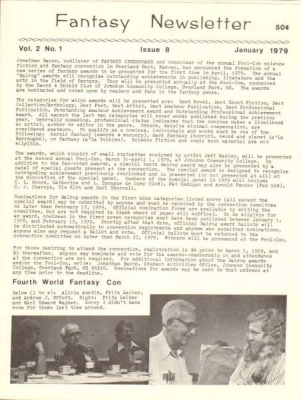
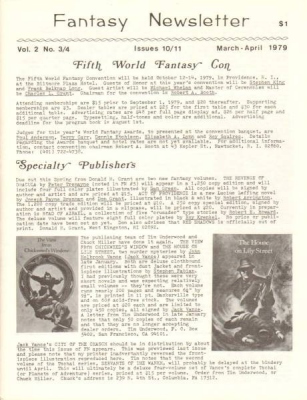
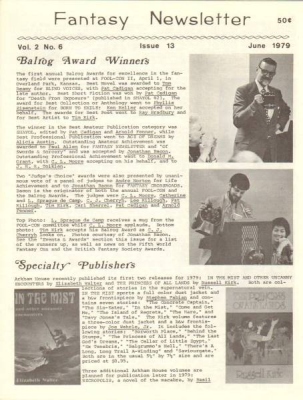
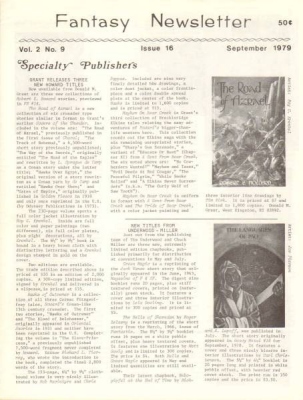
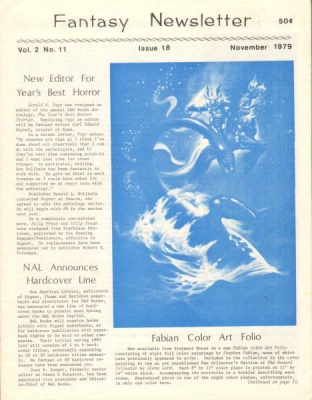
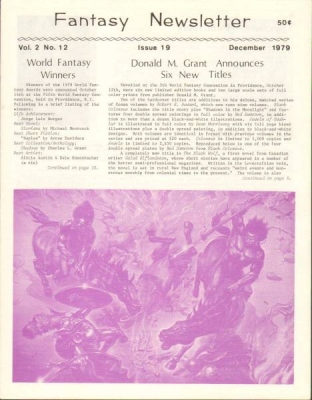
I relish glimpses of old fanzines!
Nice to get an insight into the zines content. Have seen them come up on eBay but never held one in hand.
I wonder if Jeff Easley did sculpt the awards? Maybe Scott Taylor can confirm this?
@ Steven. Do you have plans to cover The Cimmerian pro-zine sometime?
I’m currently looking at works which won awards in 1979, so The Cimmerian is not currently on my radar.